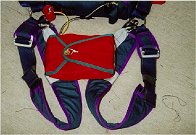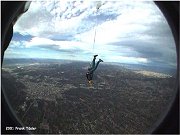| Prevention of excessive speed deployments
Is an Expert CYPRES still a helpful piece of equipment when a high speed skydive goes low?
What would be the possible outcome of a CYPRES activation at a speed of approx. 300 ft. per second or more?
The high airspeed may prevent a reserve opening in time after a CYPRES activation. And, if the CYPRES would activate in time, the force of the reserve opening would contain a high risk of serious injuries or death for the skydiver. A simple activation altitude adjustment of the Expert CYPRES would not work reliably in a Speed Skydiving emergency.
Which way to go? To handle it or to prevent it? We wanted to find a way to prevent excessive speed at pull time to get out of this deadly circle in case of a high speed emergency situation.
The idea was to measure the speed, to make the decision if the skydiver is in a critical situation, and if so, to release a drogue chute to slow the skydiver down as quick as possible. We wanted to find a way where the Speed-Skydiver is of course not restricted in attempting high speeds.
There where more targets:
There should not be any additional standard or emergency procedures and if possible no or only a minimum additional, previous not existing hazards.
The function of the regular CYPRES must never be compromised. It had to be guaranteed that the freefall speed under the drogue is ALWAYS above 78mph, also with a lightweight jumper.
The drogue chute must not interfere with the main or reserve canopy opening.
The system should be small and not expensive - the idea was to use as much standard parts as possible.
Because speed skydivers not only do speed jumps and use their equipment also for regular jumps, a separate container which allows an occasional installation looked like the best solution. The occasional installation should be easy with minimal modifications on the rig.  
Click photos to see enlargements!
After we knew what we wanted, we contacted Jürgen Sennert from Rainbow Design for the building of a prototype. He liked the idea and a week later, I drove to his loft and we started working. Jürgen Sennert was a big help during the whole testing. We gave our small container the name " speed breaker" It took us 2 days to build it.
We tested the position under the drogue and did also a lot of cutaway tests. We decided to mount a second handle for a manual cutaway without container opening in case of an entanglement with the drogue.
We mounted the Speed breaker on 4 different rigs: Talon T3, Atom 00, Javelin XRS, and on the V1A from Jürgen Sennert. Two rigs had a throw out, two rigs had a pull out. The cable length has to be checked under load when the Speed breaker is installed the first time. When the rig is prepared, the mounting takes 2 minutes.
For the beginning, we took standard components to get started - a regular spring loaded pilotchute with 28 inch diameter and a standard reserve bridle. We knew that we wouldnít get too far with these parts, but for the first tests where we wanted to know if the system works at all it seemed reasonable for us.
The planned test schedule was: 1. To find out if this piece of equipment works at all. 2. If it does, to deploy headdown 3. If headdown works, to go faster step by step 4. To find suitable components for high speed 5. To do several high speed jumps to evaluate the decelerating phase 6. Analyzing of the recorded data and to choose the parameters for a specialized high speed AAD.
Harald "Harry" Kloska was the designated test jumper. He is full time staff member of Aero Fallschirmsport in Gransee near Berlin. He has all ratings, is master rigger, free flyer and is one of the few people in Germany who is doing speed-skydiving.
As on all evaluation jumps, we used a regular Expert Cypres. It was switched on in a straight flying plane to get the higher activation altitude. The activation altitudes were all between 5300 and 7900 ft AGL.
The test jumps went from regular to fast belly flying, further to slow headdown, getting faster. The speeds started at 120 mph and climbed over 140, 156, 195 to 215 mph. The opening shock of the regular pilot chute was suitable for deployments up to approx. 190 mph. Nevertheless it didnít fly nice and carved around the jumper while trailing - but this was no wonder with this shape.
The 190 mph opening was really "sporty" - but Harald wanted to know where the limit is and found it at 215 mph. This was definitely the limit-going beyond it would have been dangerous.
The snatch force of the bridle became too big. Itís like a line dump, because the pilotchute is fully inflated before the bridle, the speed breaker harness and the leg straps are under tension. We had to find a way to avoid this. On the positive side we had a very efficient deceleration of the peak speed.
On this jump, there was an average speed of 99,5 m/sec (328.35 ft/sec) over the last 16 seconds before the activation. The average speed 16 seconds after the activation was 46,3 m/s or 152.79 ft/sec.   
[Click photos to see enlargements!]
This was a very satisfying result, because the jumper was out of the overspeed - zone inbetween 2,5 seconds. We thought about a different drogue chute . We additionally thought about another bridle - the idea was to have something elastic. After a lot of telephone calls for suitable rubber bands without success, Jürgen Sennert remembered an old round canopy from former East Germany in the last corner of his workshop.
It had a rock solid bridle with 3 layers of rubber inside with approx. 20 pounds strength. Exactly what we needed. It was used since the mid - 60ís for the retraction of the pilot chute and the packing sleeve of a round canopy. SPEKON, the German manufacturer, still has these bridles and delivered us a few.
To test it, Harry made another jump with the new bridle and the old pilotchute to evaluate the difference. An opening with~290 km/h (~180 mph) was much better. Harry was keen on getting faster and made the next jump with 380 km/h ( ~ 240 mph) and this activation had an excellent comfort because the pilotchute ripped off.
Maybe it was better this way.... As next, we wanted to know the exact difference between a speed dive with drogue chute and without. Harry made 2 jumps where he forced himself radically into the same floating position like under the "speed breaker".
These jumps were really uncomfortable for him - but showed that the extreme de- arching position of the jumper is the most effective brake - there was only a difference of 2 mph average speed after stopping the dive through extreme de- arching against a drogue chute deployment.
The new drogue chute design was ready at that time,we decided to try it with a spring loaded 26 inch balloon type, vented by a mesh ring slot around the center. It worked excellent from the beginning. We decided to increase the pull force of the bridle. SPEKON was so kind to supply us with 2 double bridles with ~ 40 pounds pull force each.
Harry Kloska made more jumps in January 2001 in Spain and increased the speed further to 271 mph and finally to 290 mph. The last jump was again slightly out of the comfort zone, but acceptable - as far you can speak about comfort at these speeds. The new bridle/drogue combination has a length of ~4,5 feet and ~ 9,5 feet under load. The short length at the beginning of the deployment should reduce the chance that the bridle creates a loop and an entanglement with a leg. The drogue trails smoothly and should also allow a reserve deployment while the drogue is still set.
The test results we collected from the test jumps made it possible to judge all aspects and to think about the right altitude and speed for a "Speed - Cypres".The positive result was the still fast speed-reduction. In all cases, the jumper was below TSO speeds within 3 seconds. This was very helpful, because we wanted an as low as possible activation altitude to avoid unnecessary activations.
Our suggestion at the moment for the activation parameters would be : if faster than~ 300 km/h at an altitude of ~1100 Meters (more than ~ 185 mph / at ~3600 ft ), the "Speed" CYPRES should fire. If the skydiver is below this limit, nothing will happen. Of course there are further tests necessary to get more knowledge. For example, test jumps with extreme heavy jumpers have to be made.
If the skydiving community sees a way in this concept, one of the next steps could be be to build a few of these special AADís. This will require some time because of the special task. These units have to be jumped in training and speed-competitions to verify if the system works as expected. The small container would also need some modification, so that for example the 3 Ring system can be re- charged after a jump without opening the container.
At this stage, the container manufacturers could step in and look at this peace of equipment with their knowledge. We are happy to supply all datas of everything that we have done until today.
Deployment speed : appr. 220 mph (The video made the pace)
Skydiver: Harald "Harry" Kloska
Fotos: Photos © 2001Frank Täsler
Article by Kai Koerner, Airtec GmbH
For further questions you can contact Kai at kai@cypres.cc, Fax: +49 2953 1293, Tel: +49 2953 989948 (direct) |


![]()